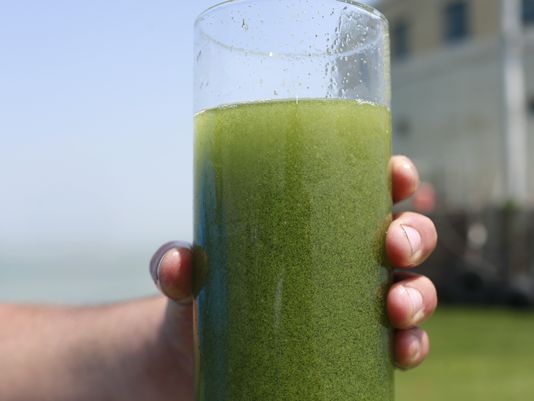Approximately 400,000 people in and around Toledo, Ohio were warned not to drink their tap water after high levels of a dangerous toxin were discovered in the water supply Saturday (according to the Toledo-Lucas County Department of Health). The toxin is called microcystin, and the high levels of it are caused by massive increases in algae on Lake Erie. This increase in algae, called “algae blooms”, are poisonous if consumed — causing abnormal liver function, diarrhea, vomiting, nausea, numbness, and dizziness. Boiling the water doesn’t help — it actually increases the presence of the toxin.
Toledo residents lived without clean water for about one week, unable to use for bathing, cooking…they couldn’t even use water to brush their teeth. Fresh water samples are being flown to a specialized U.S. Environmental Protection Agency laboratory in Cincinnati, which will determine the severity of the contamination.
This article explores 7 things you need to know about microcystin — what it does, why it’s there, and why it’s spreading in the five Great Lakes that form the largest system of fresh water in the world.

Toldeo Is Not The Only Place At Risk
The EPA has defined toxic algal blooms as “a major environmental problem” in all 50 states. The last EPA National Lakes Assessment noted that out of more than 123,000 lakes greater than 10 acres in size spread across the U.S., at least one-third may contain the toxic algae.
It’s not just the U.S., either. Brad Plumer at Vox pointed out a 2012 paper in the Polish Journal of Environmental Studies which noted that toxic algae blooms have also shown themselves in China, Japan, Brazil, and Australia. Researchers there called the worldwide increase in blooms “one of the most serious health risks of the 21st century.” “We need to increase public awareness of these issues,” Timothy Otten, a postdoctoral scholar in the OSU College of Science and College of Agricultural Sciences, told EcoWatch. “With a warming climate, rising carbon dioxide levels, dams on many rivers and overloading of nutrients into our waterways, the magnitude and duration of toxic cyanobacterial blooms is only going to get worse.”
Of course, Water to Thrive is concerned about providing clean water to communities in rural Africa. If you were moved by the issue in Toledo and want to do more for our friends in Africa suffering from toxic water, reach out to W2T today or look into ways you can help!
Approximately 400,000 people in and around Toledo, Ohio were warned not to drink their tap water after high levels of a dangerous toxin were discovered in the water supply Saturday (according to the Toledo-Lucas County Department of Health). The toxin is called microcystin, and the high levels of it are caused by massive increases in algae on Lake Erie. This increase in algae, called “algae blooms”, are poisonous if consumed — causing abnormal liver function, diarrhea, vomiting, nausea, numbness, and dizziness. Boiling the water doesn’t help — it actually increases the presence of the toxin.
Toledo residents lived without clean water for about one week, unable to use for bathing, cooking…they couldn’t even use water to brush their teeth. Fresh water samples are being flown to a specialized U.S. Environmental Protection Agency laboratory in Cincinnati, which will determine the severity of the contamination.
This article explores 7 things you need to know about microcystin — what it does, why it’s there, and why it’s spreading in the five Great Lakes that form the largest system of fresh water in the world.

Toldeo Is Not The Only Place At Risk
The EPA has defined toxic algal blooms as “a major environmental problem” in all 50 states. The last EPA National Lakes Assessment noted that out of more than 123,000 lakes greater than 10 acres in size spread across the U.S., at least one-third may contain the toxic algae.
It’s not just the U.S., either. Brad Plumer at Vox pointed out a 2012 paper in the Polish Journal of Environmental Studies which noted that toxic algae blooms have also shown themselves in China, Japan, Brazil, and Australia. Researchers there called the worldwide increase in blooms “one of the most serious health risks of the 21st century.” “We need to increase public awareness of these issues,” Timothy Otten, a postdoctoral scholar in the OSU College of Science and College of Agricultural Sciences, told EcoWatch. “With a warming climate, rising carbon dioxide levels, dams on many rivers and overloading of nutrients into our waterways, the magnitude and duration of toxic cyanobacterial blooms is only going to get worse.”
Of course, Water to Thrive is concerned about providing clean water to communities in rural Africa. If you were moved by the issue in Toledo and want to do more for our friends in Africa suffering from toxic water, reach out to W2T today or look into ways you can help!

About The Author: Water to Thrive
More posts by Water to Thrive